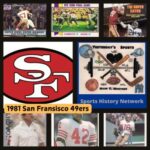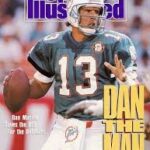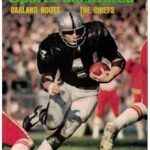The Redskins-Cowboys rivalry of the 1970s and 1980s is etched in NFL history. The rivalry began when the Redskins hired George Allen as head coach in 1971. Allen had been the head coach of the LA Rams from 1966–1970. Washington had some great teams in the 1930s and early 1940s. The Redskins had played in six NFL title games–winning two of them–but their recent history wasn’t much to brag about. From 1946–1970 they had only four winning seasons and no post-season appearances.
Note – below is an update to this post. The original article is the script for an episode of Yesterday’s Sports on the rivalry. An episode of The Football History Dude was released interviewing Mark Morthier and Frank Reading, running down memory lane to reminisce about this great rivalry. Enjoy!
The Future Is Now
Allen wanted to win right away, not in the future. His motto was “The Future is Now!” He wanted veteran players, and he was willing to trade away draft picks to get them, including getting several players who were with him in Los Angeles. Those players would enhance the team’s talent, players like Sonny Jurgensen at quarterback, Charley Taylor at wide receiver, Jerry Smith at tight end, Larry Brown at running back, and Chris Hanburger at linebacker.
Some criticized Allen for trading away top draft picks, but it was hard to argue with the results. After five weeks in 1971, the team was first in their division with a 5–0 record. The most impressive of those wins came in Week 3 against the Dallas Cowboys in the Cotton Bowl. Quarterback Billy Kilmer connected with receiver Roy Jefferson for a 50-yard score to give Washington a 14–3 lead. The Redskins prevailed that day, 20–16.
Kilmer and Jefferson were examples of how Allen stacked his team with veteran players. Kilmer came by way of the New Orleans Saints to be the team’s back-up QB to starter Sonny Jurgensen, while Jefferson came from Baltimore and was supposed to complement star receive Charley Taylor. But after Jurgenson and Taylor went down with serious injuries, Kilmer and Jefferson stepped in to fill the void.
A Rivalry Is Born
The story was a bit different for the Dallas Cowboys. Born in expansion in 1960, the team struggled to produce a winning team until 1966, when it fell one game short of reaching the Super Bowl. It was the beginning of a pattern. 1967 was the same as 1966, falling one game short of the Super Bowl. In 1968 and, again, in 1969, Dallas lost in the divisional playoff game. Dallas finally reached the Super Bowl in 1970 but lost the game on a last-second field goal.
The Cowboys and Redskins met again in 1971, Week 10, in a game played at RFK Stadium. Dallas got its revenge with a 13–0 shutout and went on to win its first-ever Super Bowl. The Redskins, on the other hand, lost their playoff game to the 49ers, 24–20. But George Allen had proved his point: no longer would the Dallas Cowboys have a free ride to the division title.
Allen, a master psychologist, knew that overtaking the Cowboys as divisional champions wouldn’t be easy. He needed more than players to do it. So he manufactured intense dislike for ‘that team’ from Texas. It wasn’t a stretch for him, either.
When he was with the Rams, the Cowboys accused Allen of sending spies to watch their practices. He resented the accusation and waited to exact revenge. It came during a 1971 regular-season game when a dog ran onto the field. Allen accused the Cowboys of using the dog to disrupt his team’s concentration. Washington won, 20–16.
So deep was Allen’s dislike that he refused to call one of his players, Dallas Hickman, by his first name. Allen’s players bought into his detest for the Cowboys, including d- lineman Diron Talbert, who focused his angst on Cowboys’ quarterback Roger Staubach. Coincidentally, Diron’s older brother Don, was a back-up offensive lineman on the 1971 Dallas Cowboys.
1972 Season
As the 1972 season approached, Washington’s goal was crystal clear: overtake Dallas as divisional champions and get to the Super Bowl. Washington drew first blood in a Week 6 match-up at RFK stadium. They won, 24–20, and moved into 1st place with a 5–1 record. But Dallas got even in Week 13 with a 34–24 victory. The ‘Skins finished the season 11–3, while the Cowboys ended at 10–4. That meant Washington was the division winner, and Dallas had to settle for a Wild Card spot in the playoffs.
Washington beat Green Bay 16–3 in the first playoff game. Dallas defeated the SF 49ers 30–28 with a furious come-from-behind rally. Those victories set up a Cowboys/Redskins match-up on New Year’s Eve in DC. The winner would go on to face the undefeated Miami Dolphins in the Super Bowl.
Cowboys’ coach Tom Landry decided to start Roger Staubach at quarterback over Craig Morton even though Staubach had missed most of the season because of shoulder surgery. Few questioned the decision since it was Staubach who engineered that comeback win over the 49ers.
But starting Staubach wasn’t enough. The Redskins cruised to a 26–3 win. Quarterback Billy Kilmer completed 14 of 18 passes for 194 yards with two touchdowns and zero interceptions.
Receiver Charley Taylor caught seven passes for 146 yards and scored two touchdowns. Afterward, Diron Talbert implied that it was easier to beat the Cowboys with Roger Staubach at the helm rather than Craig Morton. That insinuation incensed Staubach, who vowed to get even.
A snafu gave Staubach reason to smile. Those in charge of ordering shoes for the big game must have thought that the Cowboys would be Miami’s opponent. Burgundy shoes–the ‘Skins color–never arrived.
Talbert was irate when he saw that they would be wearing blue shoes (the Cowboys color) for the big game. It got worse from there: the Redskins lost the Super Bowl to the Miami Dolphins 14–7.
Redskins vs. Cowboys: Rivalry 1973-1979
These two rivals went back and forth, winning and losing, taunting each other, in one of the NFL’s most memorable rivalries.
In 1973, the Cowboys looked forward to getting revenge in a Week 4 game played at RFK Stadium on Monday Night Football. The Cowboys led 7–0 after three quarters in a hard-hitting defensive game, but the Redskins came back to take a 14–7 lead.
In a memorable conclusion, the Cowboys came within one yard of tying the game as time expired. Defensive back Ken Houston, who had been acquired recently from the Oilers, stopped Cowboys’ fullback, Walt Garrison, from scoring on fourth down.
Some years ago, I had an opportunity to ask Mr. Houston about that play. I prefaced my question to him by letting him know I was an 11-year-old Dallas Cowboys fanatic at the time and that he had caused me a very bad nights’ sleep. He found that rather amusing. “It was probably the most important game of my career,” said Houston.
“I had just been traded to Washington during the off-season after playing with the Houston Oilers for six years. After that Monday Night game, I felt I was accepted by my new teammates as a Washington Redskin”.
Dallas got a measure of revenge in a Week 13 game, winning 27- 7. The win was an extremely important one for Dallas, who came into the game with a 7-4 record, while Washington came in at 8-3. A loss would have put them two games behind Washington with only two games left in the season.
Both teams finished the season at 10-4, so essentially the 27-7 win gave Dallas the division title while Washington had to settle for the wild-card spot. But there would be no rematch in the postseason. Washington lost to Minnesota in the playoff game. Dallas got to play the Vikings the following week in the NFC title game and lost, too.
1974 did not go well for the Cowboys. Many of their leading players had retired during the off-season. Others, including players past their prime, were traded. They lost to Washington in Week 10, 28–21, and that loss left the team with a 5–5 record with a slim chance of reaching the playoffs.
They met again only 11 days later on Thanksgiving Day. Diron Talbert predicted that the Redskins would knock Roger Staubach out of the game, and that’s precisely what happened.
Behind 23–17 with time running out, rookie backup quarterback Clint Longley threw a 50 yard pass to receiver Drew Pearson, and the Cowboys won, 24–23. But Dallas finished 8–6 and missed the playoffs for the first time since 1965. Washington finished 10–4 but had to settle for a Wild Card spot as the surprising St. Louis Cardinals took the division title. The Redskins were quickly eliminated by the Rams in the playoffs.
The Cowboys started the 1975 season with a 5–1 record, but the habit of losing at RFK continued in Week 7 with a 30–24 OT loss. Likewise, the Redskins’ struggles at Texas Stadium continued. They were humiliated, 31–10, in Week 13. The win was sweet for Dallas because it knocked the ‘Skins out of the playoffs. Dallas, on the other hand, made it to the Super Bowl but lost a close game to the Steelers 21–17.
In Week 8 of the 1976 season, the Cowboys finally beat the Redskins at RFK, 20–7, but then lost to them in Week 14 at Texas Stadium, 27–14. It would mark the first time Washington ever defeated the Cowboys at Texas Stadium. Dallas won the division with an 11–3 record. Washington had to settle for the Wild Card spot again. It didn’t matter, though, as both teams lost opening-round playoff games.
Learn more here about the epic season of the 1976 Washington Redskins.
In Week 5 of the 1977 season, the Cowboys easily defeated the Skins, 34–16. They met again in Week 11, and the Cowboys won again, 14–7, eliminating the Redskins from the playoffs. It was the first time since 1970 that Dallas had beaten the Redskins twice in the same season. Better yet, the Cowboys finished the season hoisting their second Vince Lombardi Trophy.
The Redskins 1978 season started out with a new head coach, Jack Pardee, and a new starting quarterback, Joe Theismann. Theisman had played several seasons in the CFL before joining the Redskins in 1974, but, first, he had to compete with vets Sonny Jurgensen and Billy Kilmer for playing time. He finally got a chance to start in 1978.
But with George Allen out of the picture, the Redskins-Cowboys rivalry seemed to have lost some luster. The shine came back quickly in an October Monday Night game at RFK. With a 9–3 lead and time running out in the 4th, the Redskins took a safety rather than punt the ball. As QB Joe Theismann ran around the end zone to run out the clock, he held up the ball, taunting the Cowboys’ defense.
The Cowboys vowed revenge and they got it on Thanksgiving Day, winning 37–10 in a rout. Dallas back-up fullback Scott Laidlaw had the best game of his career, carrying the ball 16 times for 122 yds and two touchdowns. A phone call in the 4th quarter made the win bittersweet for me and my brother. The caller was a family member, informing us that our grandfather had died. Dallas went on to play in the Super Bowl. Washington finished 8–8 after starting 6–0.
The Redskins got a bit of payback in Week 12 of the 1979 season, winning 34–20. But Dallas had the last laugh, eliminating the ‘Skins (once again) from playoff contention in the regular season’s final game. It was a game in which the Cowboys had to come from behind twice. The first time from a 17 point deficit and the second time from a 13 point deficit. To quote fellow podcaster and long-time Washington fan Frank Reading “it was of the best games I’ve ever seen”.
The win was made even sweeter because a pre-game taunt went sour. Prior to the game, a funeral wreath was delivered to the home of Cowboys’ DE Harvey Martin with a card attached that read, “From the Redskins.” Martin brought the wreath to the game and was happy to throw it into the Redskins’ locker room after the Cowboys’ win. But unbeknownst to Martin, the wreath didn’t come from the Redskins. It was a stunt, delivered by a Cowboys’ fan, designed to get Martin fired up for the game. It worked, too.
Redskins vs. Cowboys Rivalry of the 80s
In 1980, the Cowboys came close to going to their 6th Super Bowl, losing to the Eagles in the NFC Championship game. The Redskins, on the other hand, lost both regular-season games to the Cowboys and finished the season at 6–10–their worst record since 1968.
In 1981, the Cowboys were less than a minute away from playing in the Super Bowl, but that quest was denied by the 49ers, 28–27. The Redskins had a new head coach in Joe Gibbs and finished the season at 8–8. As it did in 1980, the team lost both regular-season games to the Cowboys.
For Washington, a negative pattern was in place–with five consecutive losses to Dallas and no playoff appearance in five years. The rivalry had lost a lot of its luster. Things turned around in the strike-shortened 1982 season, Washington finished 11–1 (including two playoff games). But what could have been a perfect season was tarnished by the sixth straight loss to Dallas.
The Cowboys finished 8–3 (including playoffs). And to put the icing on the cake, the two teams would meet again, this time in the NFC Championship game played at RFK Stadium. The Redskins not only got revenge–knocking Cowboys’ QB Danny White out of the game, and cruising to a 31–17 win–they ended up going all the way, winning their first Super Bowl.
That championship game gave the rivalry renewed energy. The rematch, which took place on Sept. 5, 1983, at RFK Stadium, was a barnburner. Played on a hot and humid Monday night in front of a national audience, the game ended up being a tumultuous affair. Washington stormed out to take a 23–3 halftime lead but then watched Dallas storm back to win, 31–30.
The Redskins had a chance to return the favor in Week 15–and did just that–winning 31–10. The Cowboys finished the season in second place (12–4) and then lost in the first round of the playoffs. Meanwhile, the Redskins marched into the Super Bowl at 16–2, where the Raiders handled them with ease, 38–9.
The rivalry made history in 1984 when Washington beat Dallas twice–something the team had never done previously. Some satisfaction in that accomplishment was lost because Dallas had an uncharacteristically bad year. It was only the second time in 20 years that the ‘Boys had failed to qualify for the playoffs. But every time it seemed as though the rivalry was a thing of the past, something happened to keep it alive. 1984 was no different.
In their second meeting of the year, the ‘Skins were up 30–28 with very little time left on the clock. Washington needed to run out the clock, which is an easy QB assignment: the ‘victory formation’ would fill the bill. But cocky Joe Theismann decided otherwise.
Three times in a row, Theismann dropped to one knee and then got up and ran around the backfield. Cowboys’ cornerback Ron Fellows, who had enough of it, leveled Theismann. A bench-clearing brawl ensued, and the referees decided to end the game with 24 seconds remaining on the clock.
Redskins vs. Cowboys Rivalry Slows Down
There was a carryover to 1985. On a hot September night in Texas, the Cowboys had vengeance on their mind as the teams took the field for the Monday Night game. Dallas whomped the Redskins, 44–14, and humiliated Theismann, who finished the game with a 32.3 passer rating.
To make matters worse for Thesmann, his poor performance occurred on his birthday and the fans taunted him by singing happy birthday to Joey.
The Cowboys repeated that feat, beating Washington again in Week 10–one week before Theismann suffered a horrific leg injury that would end his career. The Cowboys were sad to see him go. Theismann did, after all, add spice to a hot rivalry.
But history would show that the rivalry was coming to an end. The teams split games in 1986, but neither game was close or memorable. One reason is that the Cowboys had a losing year, their first losing record in nearly 20 years.
But Washington was still on the uptick. The ‘Skins made it to the NFC Championship game but went no further (shutout by the Giants). They got redemption in 1987 with a Super Bowl win. Doug Williams was under center that year. And the ‘Skins won it again in 1991 with Mark Ripken at QB.
Since 1991, the Redskins have won 10 games in a season only three times. They’ve made the playoffs six times, never advancing beyond the divisional stage.
The Cowboys, on the other hand, had five consecutive losing seasons from 1986–1990. But things began to turnaround when Jerry Jones bought the team in 1989. Jones made drastic changes, including releasing iconic Tom Landry as head coach and hiring Jimmy Johnson, who made a number of chancy trades.
Jones and Johnson–both with Razorback roots–were a good pair. The team responded by winning three Super Bowls (1992, 1993, and 1995). But the ‘Boys have been generally unremarkable since. Since 1996, they’ve never made it beyond the divisional round of the playoffs.
Today, when Washington plays Dallas, it’s another game on the schedule. But from 1971 to 1985, it was one of the best rivalries the NFL has ever known.
Speaking of rivalries, here’s an article to take you way back to the beginning of the NFL’s oldest rivalry. The teams involved may surprise you.
Resources
Please Note – As an Amazon Associate I earn from qualifying purchases
More From Yesterday's Sports
1981 San Fransisco 49ers: First Super Bowl Victory
The San Francisco 49ers franchise began in 1946 in the...
Read MoreMonday Night Football Early Years (1985 – 1991)
Before we jump into Monday Night Football from 1985 thru...
Read MoreMonday Night Football Early Years (1979 – 1984)
Before we jump into Monday Night Football from 1979 thru...
Read MoreMonday Night Football Early Years (1974 – 1978)
Before we jump into Monday Night Football from 1974 thru...
Read More


